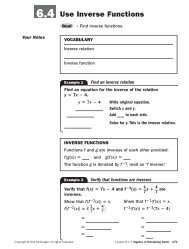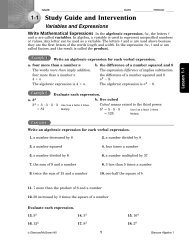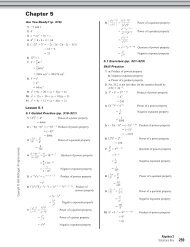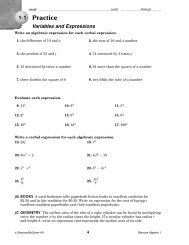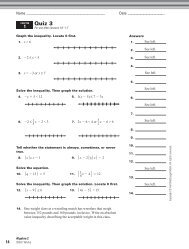real-world applications - MathnMind
real-world applications - MathnMind
real-world applications - MathnMind
You also want an ePaper? Increase the reach of your titles
YUMPU automatically turns print PDFs into web optimized ePapers that Google loves.
NAME _______________________________________________________ DATE _____________________________________<br />
REAL-WORLD APPLICATIONS<br />
STUDENT ACTIVITY for Transparency 1<br />
Use with Lesson 1-8.<br />
About the World’s Major Producers and Consumers of Primary Energy<br />
Many everyday activities of Americans are extremely energy dependent. For example, think<br />
about a mathematics classroom in an energy sense. Having the lights on consumes electricity.<br />
The air temperature is regulated by heating and cooling systems that directly or indirectly<br />
consume fossil fuels. Pens, pencils, and calculators are manufactured by machines that require<br />
energy to operate. There are many other ways that energy is used directly or indirectly.<br />
The amount of energy a person consumes and the amount of energy that needs to be produced<br />
on an individual’s behalf may be reduced through improved energy efficiency. New, more<br />
efficient light bulbs, appliances, and household products are becoming increasingly available<br />
to consumers. Until technology catches up with energy consumption, however, turning off<br />
unnecessary lights and being more energy conscious are steps in the right direction.<br />
Directions: Use what you have seen and read to answer the following questions.<br />
1. Which countries shown in the graphs consume more energy than they produce? United States,<br />
China, Japan, Germany, India, France, and Brazil consume more energy than they<br />
produce.<br />
2. Which countries produce more energy than they consume? Russia, Saudi Arabia, Canada,<br />
United Kingdom, Iran, Mexico, and Australia produce more energy than they<br />
consume.<br />
3. In 1999, the United States and Russia combined to produce 30% of the <strong>world</strong>’s energy. How much<br />
energy was produced in the <strong>world</strong> in 1999? In 1999, 379.4 quadrillion Btu of energy were<br />
produced.<br />
4. In that same year, the United States, China, and Russia consumed 41% of the <strong>world</strong>’s energy. How<br />
much energy was consumed in the <strong>world</strong> in 1999? In 1999, 377.9 quadrillion Btu were<br />
consumed.<br />
Making the Connection<br />
5. Working together with your family members, estimate how much money your family spends each year<br />
on energy. See students’ work.<br />
© Glencoe/McGraw-Hill T1 Glencoe Algebra 1



